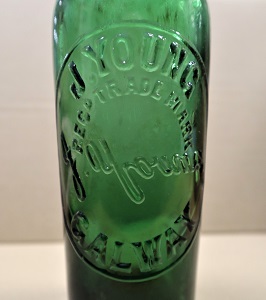JOE YOUNG’S AERATED WATERS

by Tom Kenny
Joseph Young was appointed manager of Messrs. Thomas Tracey’s Mineral Water works and Licensed Premises in Mary Street after the death of Thomas Tracey. He later married the niece of Mrs.Tracey, (Miss Edith O’Connor of Clifden) and Mrs. Tracey signed over the works to Joe Young on the marriage.
Hardiman, in his 1820 history of Galway, wrote about a well that was reputedly 1,000 years old, described as a “Chalybeate spring of the same class as the celebrated Scarborough Waters, outside the East Gate was in great repute here. A spa house has been erected over it by a Mr. Eyre and is much frequented”. Hardiman attributed the numerous instances of longevity in the area to the tonic quality of the water in this well.
It was first analysed in 1751 by John Rutty MD, who described it as being “chiefly ferrungious, as well as iron, it contained salts which rendered it a sweetener of acids”. Many doctors of the period prescribed it and it produced satisfactory results in cases of anaemia, disorders of the blood etc. This 250 feet deep spa was part of Thomas Tracey’s mineral water works which had also been used for a vinegar making business. There was some legal dispute about the ownership of some land between Joe Young and John Forde who owned the pub on the corner which was eventually resolved in Mr. Young’s favour, and in the 1920s he acquired possession of the land in which the spring was.
He had also acquired possession of a large premises on Eglinton Street. In 1925, he replaced the old building with the new structure we see in our photograph and installed new machinery, making his plant ‘the largest and best equipped factory of its kind west of the Shannon’.
In 1931, Dr. T. Walshe did an analysis of the water in the well and declared it free from all contamination, containing a negligible amount of organic matter and suitable in every way as a safe foundation for first class mineral water”. Only the water from this spring was used in the manufacture of Young’s famous aerated waters, or as they were known locally ‘Joe Young’s windy wathers’. “The soda water is bright and sparkling in appearance, free from deposit and highly impregnated with purified carbonic acid gas”.
In the late 1940s he installed a complete new plant with American and British machinery. The public were invited to see it at any time. In fact, hundreds of citizens of Galway, with the permission of the proprietor, used to call there daily for their supplies of household drinking water.
Joe Young also bottled wines, beer, stout and whiskies which was a major part of his business, and they did a very god line of soda water siphons. He was a committed Unionist, a member of the Urban District Council. On one famous occasion, at a meeting, Mícheál Walsh, the proprietor of the Old malt Pub and an ardent republican, proposed that they should extend the toll system to the docks, put a toll hut there and get every ship that came in, including the British Navy, to pay a toll. Joe Young leaped to his feet and said “If that was the case, no British Naval ship would ever come into the docks”. “I rest my case” was Walsh’s reply.
Young once proposed a motion to the Council that “An immediate settlement (to the ongoing War of Independence) can be affected by an amendment of the present Act on the basis of granting to Ireland fiscal autonomy subject to a fair amount of Imperial charge”. The motion was carried, a reflection of the similar “White Feather” decision by the County Council.

Young’s brother Sandy, a major in the Black Watch, was awarded a Victoria Cross for his bravery in the Battle of the Somme during First World War, and sadly, he was killed later in another battle.
When Young’s mineral water business closed down, the building was converted to the Oyster Bar and a Five Star supermarket. The pub was later called The Lion’s Tower.
Our photograph shows the Eglinton Street façade c.1925, a company advertisement .c1900 and a Joe Young mineral water bottle c.1900 which was found in the Corrib near Inchagoill many years ago by Adrian Ryder. Does anyone know where these bottles were made?

